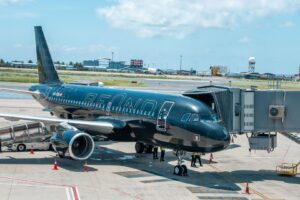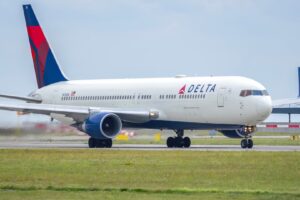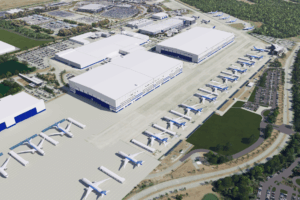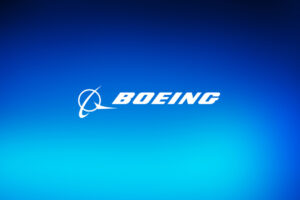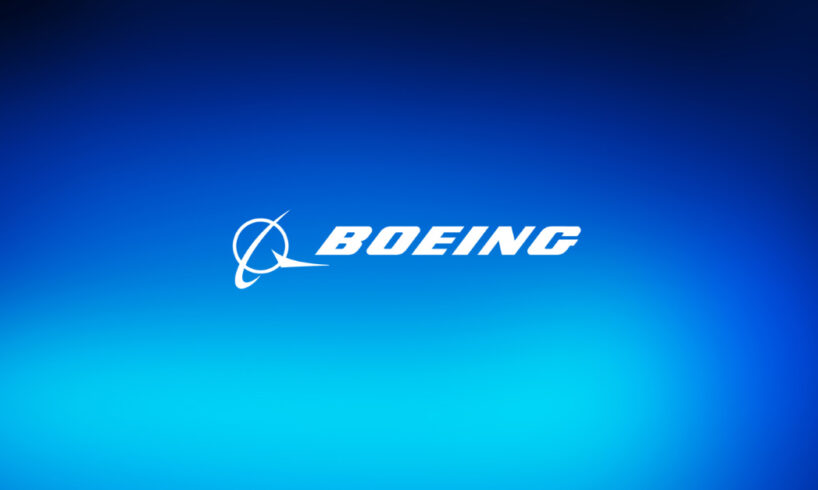
ARLINGTON, Va., July 29, 2025 /PRNewswire/ —
Second Quarter 2025
737 production reached 38 per month in the quarterRevenue increased to $22.7 billion primarily reflecting 150 commercial deliveriesGAAP loss per share of ($0.92) and core loss per share (non-GAAP)* of ($1.24)Operating cash flow of $0.2 billion and free cash flow (non-GAAP)* of ($0.2) billionTotal company backlog grew to $619 billion, including over 5,900 commercial airplanes
Table 1. Summary Financial Results
Second Quarter
First Half
(Dollars in Millions, except per share data)
2025
2024
Change
2025
2024
Change
Revenues
$22,749
$16,866
35 %
$42,245
$33,435
26 %
GAAP
(Loss)/earnings from operations
($176)
($1,090)
NM
$285
($1,176)
NM
Operating margins
(0.8)
%
(6.5)
%
NM
0.7
%
(3.5)
%
NM
Net loss
($612)
($1,439)
NM
($643)
($1,794)
NM
Diluted loss per share
($0.92)
($2.33)
NM
($1.09)
($2.90)
NM
Operating cash flow
$227
($3,923)
NM
($1,389)
($7,285)
NM
Non-GAAP*
Core operating loss
($433)
($1,392)
NM
($234)
($1,780)
NM
Core operating margins
(1.9)
%
(8.3)
%
NM
(0.6)
%
(5.3)
%
NM
Core loss per share
($1.24)
($2.90)
NM
($1.73)
($4.04)
NM
*Non-GAAP measure; complete definitions of Boeing’s non-GAAP measures are on page 5, “Non-GAAP Measures Disclosures.”
The Boeing Company [NYSE: BA] recorded second quarter revenue of $22.7 billion, GAAP loss per share of ($0.92) and core loss per share (non-GAAP)* of ($1.24). The company reported operating cash flow of $0.2 billion and free cash flow (non-GAAP)* of ($0.2) billion. Results primarily reflect improved operational performance and commercial delivery volume.
“Our fundamental changes to strengthen safety and quality are producing improved results as we stabilize our operations and deliver higher quality airplanes, products and services to our customers,” said Kelly Ortberg, Boeing president and chief executive officer. “As we look to the second half of the year, we remain focused on restoring trust and making continued progress in our recovery while operating in a dynamic global environment.”
Table 2. Cash Flow
Second Quarter
First Half
(Millions)
2025
2024
2025
2024
Operating cash flow
$227
($3,923)
($1,389)
($7,285)
Less additions to property, plant & equipment
($427)
($404)
($1,101)
($971)
Free cash flow*
($200)
($4,327)
($2,490)
($8,256)
*Non-GAAP measure; complete definitions of Boeing’s non-GAAP measures are on page 5, “Non-GAAP Measures Disclosures.”
Operating cash flow was $0.2 billion in the quarter reflecting higher commercial deliveries, as well as working capital timing.
Table 3. Cash, Marketable Securities and Debt Balances
Quarter End
(Billions)
2Q 2025
1Q 2025
Cash and investments in marketable securities1
$23.0
$23.7
Consolidated debt
$53.3
$53.6
1 Marketable securities consist primarily of time deposits due within one year classified as “short-term investments.”
Cash and investments in marketable securities totaled $23.0 billion, compared to $23.7 billion at the beginning of the quarter, primarily driven by the debt repayment and free cash flow usage in the quarter. Debt was $53.3 billion, down from $53.6 billion at the beginning of the quarter due to the pay down of maturing debt. The company maintains access to credit facilities of $10.0 billion, which remain undrawn.
Total company backlog at quarter end was $619 billion.
Segment Results
Commercial Airplanes
Table 4. Commercial Airplanes
Second Quarter
First Half
(Dollars in Millions)
2025
2024
Change
2025
2024
Change
Deliveries
150
92
63 %
280
175
60 %
Revenues
$10,874
$6,003
81 %
$19,021
$10,656
79 %
Loss from operations
($557)
($715)
NM
($1,094)
($1,858)
NM
Operating margins
(5.1)
%
(11.9)
%
NM
(5.8)
%
(17.4)
%
NM
Commercial Airplanes second quarter revenue of $10.9 billion and operating margin of (5.1) percent primarily reflect higher deliveries.
The 737 program increased the production rate to 38 per month in the quarter and plans to stabilize at that rate before requesting approval to increase to 42 per month later this year. The 787 program production rate is now at seven per month.
Commercial Airplanes booked 455 net orders in the quarter, including 120 787 and 30 777-9 airplanes for Qatar Airways and 32 787-10 airplanes for British Airways. Commercial Airplanes delivered 150 airplanes during the quarter, and backlog included over 5,900 airplanes valued at $522 billion.
Defense, Space & Security
Table 5. Defense, Space & Security
Second Quarter
First Half
(Dollars in Millions)
2025
2024
Change
2025
2024
Change
Revenues
$6,617
$6,021
10 %
$12,915
$12,971
— %
Earnings/(loss) from operations
$110
($913)
NM
$265
($762)
NM
Operating margins
1.7
%
(15.2)
%
NM
2.1
%
(5.9)
%
8.0 pts
Defense, Space & Security second quarter revenue was $6.6 billion. Second quarter operating margin of 1.7 percent reflects stabilizing operational performance.
During the quarter, Defense, Space & Security captured an award from the U.S. Air Force to build four T-7A Red Hawk production representative aircraft and began ground testing on the first MQ-25 Stingray for the U.S. Navy. Backlog at Defense, Space & Security grew to $74 billion with 22 percent representing orders from customers outside the U.S.
Global Services
Table 6. Global Services
Second Quarter
First Half
(Dollars in Millions)
2025
2024
Change
2025
2024
Change
Revenues
$5,281
$4,889
8 %
$10,344
$9,934
4 %
Earnings from operations
$1,049
$870
21 %
$1,992
$1,786
12 %
Operating margins
19.9
%
17.8
%
2.1 pts
19.3
%
18.0
%
1.3 pts
Global Services second quarter revenue was $5.3 billion. Second quarter operating margin of 19.9 percent reflects favorable performance and mix.
In the quarter, Global Services completed the sale of its maintenance, repair and overhaul facility at Gatwick Airport and secured a contract to provide P-8A aircraft training systems and support to the Republic of Korea Navy.
Additional Financial Information
Table 7. Additional Financial Information
Second Quarter
First Half
(Dollars in Millions)
2025
2024
2025
2024
Revenues
Unallocated items, eliminations and other
($23)
($47)
($35)
($126)
Loss from operations
Unallocated items, eliminations and other
($1,035)
($634)
($1,397)
($946)
FAS/CAS service cost adjustment
$257
$302
$519
$604
Other income, net
$325
$248
$648
$525
Interest and debt expense
($710)
($673)
($1,418)
($1,242)
Effective tax rate
(9.1)
%
5.0
%
(32.6)
%
5.2
%
Unallocated items, eliminations and other includes an earnings charge of $445 million resulting from the May 2025 non-prosecution agreement with the U.S. Department of Justice.
Non-GAAP Measures Disclosures
We supplement the reporting of our financial information determined under Generally Accepted Accounting Principles in the United States of America (GAAP) with certain non-GAAP financial information. The non-GAAP financial information presented excludes certain significant items that may not be indicative of, or are unrelated to, results from our ongoing business operations. We believe that these non-GAAP measures provide investors with additional insight into the company’s ongoing business performance. These non-GAAP measures should not be considered in isolation or as a substitute for the related GAAP measures, and other companies may define such measures differently. We encourage investors to review our financial statements and publicly-filed reports in their entirety and not to rely on any single financial measure. The following definitions are provided:
Core Operating Earnings/(Loss), Core Operating Margins and Core Earnings/(Loss) Per Share
Core operating earnings/(loss) is defined as GAAP Earnings/(loss) from operations excluding the FAS/CAS service cost adjustment. The FAS/CAS service cost adjustment represents the difference between the Financial Accounting Standards (FAS) pension and postretirement service costs calculated under GAAP and costs allocated to the business segments. Core operating margins is defined as Core operating earnings/(loss) expressed as a percentage of revenue. Core earnings/(loss) per share is defined as GAAP Diluted earnings/(loss) per share excluding the net earnings/(loss) per share impact of the FAS/CAS service cost adjustment and Non-operating pension and postretirement expenses. Non-operating pension and postretirement expenses represent the components of net periodic benefit costs other than service cost. Pension costs allocated to BDS and BGS businesses supporting government customers are computed in accordance with U.S. Government Cost Accounting Standards (CAS), which employ different actuarial assumptions and accounting conventions than GAAP. CAS costs are allocable to government contracts. Other postretirement benefit costs are allocated to all business segments based on CAS, which is generally based on benefits paid. Management uses core operating earnings/(loss), core operating margins and core earnings/(loss) per share for purposes of evaluating and forecasting underlying business performance. Management believes these core measures provide investors additional insights into operational performance as they exclude non-service pension and post-retirement costs, which primarily represent costs driven by market factors and costs not allocable to government contracts. A reconciliation of these non-GAAP measures to the most directly comparable GAAP measure is provided on page 12 and 13.
Free Cash Flow
Free cash flow is GAAP operating cash flow reduced by capital expenditures for property, plant and equipment. Management believes free cash flow provides investors with an important perspective on the cash available for shareholders, debt repayment, and acquisitions after making the capital investments required to support ongoing business operations and long term value creation. Free cash flow does not represent the residual cash flow available for discretionary expenditures as it excludes certain mandatory expenditures such as repayment of maturing debt. Management uses free cash flow as a measure to assess both business performance and overall liquidity. See Table 2 on page 2 for a reconciliation of free cash flow to the most directly comparable GAAP measure, operating cash flow.
Caution Concerning Forward-Looking Statements
This press release contains “forward-looking statements” within the meaning of the Private Securities Litigation Reform Act of 1995. Words such as “may,” “will,” “should,” “expects,” “intends,” “projects,” “plans,” “believes,” “estimates,” “targets,” “anticipates,” and other similar words or expressions, or the negative thereof, generally can be used to help identify these forward-looking statements. Examples of forward-looking statements include statements relating to our future financial condition and operating results, industry projections and outlooks, plans, objectives and goals, as well as any other statement that does not directly relate to any historical or current fact. Forward-looking statements are based on expectations and assumptions that we believe to be reasonable when made, but that may not prove to be accurate.
These statements are not guarantees and are subject to risks, uncertainties, and changes in circumstances that are difficult to predict. Many factors could cause actual results to differ materially and adversely from these forward-looking statements. Among these factors are risks related to: (1) general conditions in the economy and our industry, including those due to regulatory changes; (2) our reliance on our commercial airline customers; (3) the overall health of our aircraft production system, production quality issues, commercial airplane production rates, our ability to successfully develop and certify new aircraft or new derivative aircraft, and the ability of our aircraft to meet stringent performance and reliability standards; (4) changing budget and appropriation levels and acquisition priorities of the U.S. government, as well as significant delays in U.S. government appropriations; (5) our dependence on our subcontractors and suppliers, as well as the availability of highly skilled labor and raw materials; (6) work stoppages or other labor disruptions; (7) competition within our markets; (8) our non-U.S. operations and sales to non-U.S. customers, including tariffs, trade restrictions and government actions; (9) changes in accounting estimates; (10) our pending acquisition of Spirit AeroSystems Holdings, Inc. (Spirit), including the satisfaction of closing conditions in the expected timeframe or at all; (11) realizing the anticipated benefits of mergers, acquisitions, joint ventures/strategic alliances or divestitures, including anticipated synergies and quality improvements related to our pending acquisition of Spirit; (12) our dependence on U.S. government contracts; (13) our reliance on fixed-price contracts; (14) our reliance on cost-type contracts; (15) contracts that include in-orbit incentive payments; (16) management of a complex, global IT infrastructure; (17) compromised or unauthorized access to our, our customers’ and/or our suppliers’ information and systems; (18) potential business disruptions, including threats to physical security or our information technology systems, extreme weather (including effects of climate change) or other acts of nature, and pandemics or other public health crises; (19) potential adverse developments in new or pending litigation and/or government inquiries or investigations; (20) potential environmental liabilities; (21) effects of climate change and legal, regulatory or market responses to such change; (22) credit rating agency actions and our ability to effectively manage our liquidity; (23) substantial pension and other postretirement benefit obligations; (24) the adequacy of our insurance coverage; (25) customer and aircraft concentration in our customer financing portfolio; (26) the dilutive effect of future issuances of our common stock; and (27) the preferential treatment of our 6.00% mandatory convertible preferred stock.
Additional information concerning these and other factors can be found in our filings with the Securities and Exchange Commission, including our most recent Annual Report on Form 10-K, Quarterly Reports on Form 10-Q and Current Reports on Form 8-K. Any forward-looking statement speaks only as of the date on which it is made, and we assume no obligation to update or revise any forward-looking statement, whether as a result of new information, future events, or otherwise, except as required by law.
The Boeing Company and Subsidiaries
Consolidated Statements of Operations
(Unaudited)
Six months ended
June 30
Three months ended
June 30
(Dollars in millions, except per share data)
2025
2024
2025
2024
Sales of products
$35,269
$26,792
$19,122
$13,524
Sales of services
6,976
6,643
3,627
3,342
Total revenues
42,245
33,435
22,749
16,866
Cost of products
(31,785)
(24,971)
(17,406)
(12,907)
Cost of services
(5,608)
(5,359)
(2,908)
(2,730)
Total costs and expenses
(37,393)
(30,330)
(20,314)
(15,637)
4,852
3,105
2,435
1,229
Income from operating investments, net
28
74
25
7
General and administrative expense
(2,905)
(2,538)
(1,793)
(1,377)
Research and development expense, net
(1,754)
(1,822)
(910)
(954)
Gain on dispositions, net
64
5
67
5
Earnings/(loss) from operations
285
(1,176)
(176)
(1,090)
Other income, net
648
525
325
248
Interest and debt expense
(1,418)
(1,242)
(710)
(673)
Loss before income taxes
(485)
(1,893)
(561)
(1,515)
Income tax (expense)/benefit
(158)
99
(51)
76
Net loss
(643)
(1,794)
(612)
(1,439)
Less: net earnings/(loss) attributable to noncontrolling interest
5
(12)
(1)
Net loss attributable to Boeing shareholders
(648)
(1,782)
(611)
(1,439)
Less: Mandatory convertible preferred stock dividends
accumulated during the period
172
86
Net loss attributable to Boeing common shareholders
($820)
($1,782)
($697)
($1,439)
Basic loss per share
($1.09)
($2.90)
($0.92)
($2.33)
Diluted loss per share
($1.09)
($2.90)
($0.92)
($2.33)
The Boeing Company and Subsidiaries
Consolidated Statements of Financial Position
(Unaudited)
(Dollars in millions, except per share data)
June 30
2025
December 31
2024
Assets
Cash and cash equivalents
$7,087
$13,801
Short-term and other investments
15,880
12,481
Accounts receivable, net
3,190
2,631
Unbilled receivables, net
9,261
8,363
Current portion of financing receivables, net
16
207
Inventories
87,853
87,550
Other current assets, net
2,563
2,965
Assets held for sale
1,451
Total current assets
127,301
127,998
Financing receivables and operating lease equipment, net
318
314
Property, plant and equipment, net of accumulated depreciation of $23,208 and $22,925
11,658
11,412
Goodwill
7,280
8,084
Acquired intangible assets, net
1,542
1,957
Deferred income taxes
136
185
Investments
1,036
999
Other assets, net of accumulated amortization of $879 and $1,085
5,849
5,414
Total assets
$155,120
$156,363
Liabilities and equity
Accounts payable
$11,238
$11,364
Accrued liabilities
23,508
24,103
Advances and progress billings
59,407
60,333
Short-term debt and current portion of long-term debt
8,719
1,278
Liabilities held for sale
504
Total current liabilities
103,376
97,078
Deferred income taxes
193
122
Accrued retiree health care
2,116
2,176
Accrued pension plan liability, net
5,803
5,997
Other long-term liabilities
2,324
2,318
Long-term debt
44,604
52,586
Total liabilities
158,416
160,277
Shareholders’ equity:
Mandatory convertible preferred stock, 6.00% Series A, par value $1.00 –
20,000,000 shares authorized; 5,750,000 shares issued; aggregate
liquidation preference $5,750
6
6
Common stock, par value $5.00 – 1,200,000,000 shares authorized;
1,012,261,159 shares issued
5,061
5,061
Additional paid-in capital
19,238
18,964
Treasury stock, at cost – 256,638,054 and 263,044,840 shares
(31,603)
(32,386)
Retained earnings
14,542
15,362
Accumulated other comprehensive loss
(10,539)
(10,915)
Total shareholders’ deficit
(3,295)
(3,908)
Noncontrolling interests
(1)
(6)
Total equity
(3,296)
(3,914)
Total liabilities and equity
$155,120
$156,363
The Boeing Company and Subsidiaries
Consolidated Statements of Cash Flows
(Unaudited)
Six months ended June 30
(Dollars in millions)
2025
2024
Cash flows – operating activities:
Net loss
($643)
($1,794)
Adjustments to reconcile net loss to net cash used by operating activities:
Non-cash items –
Share-based plans expense
254
208
Treasury shares issued for 401(k) contribution
793
953
Depreciation and amortization
926
883
Investment/asset impairment charges, net
30
34
Gain on dispositions, net
(64)
(5)
Other charges and credits, net
162
(34)
Changes in assets and liabilities –
Accounts receivable
(683)
(522)
Unbilled receivables
(908)
(1,345)
Advances and progress billings
(616)
1,886
Inventories
(374)
(5,937)
Other current assets
265
(320)
Accounts payable
(46)
(222)
Accrued liabilities
(248)
(443)
Income taxes receivable, payable and deferred
(3)
(188)
Other long-term liabilities
(212)
(148)
Pension and other postretirement plans
(292)
(491)
Financing receivables and operating lease equipment, net
185
149
Other
85
51
Net cash used by operating activities
(1,389)
(7,285)
Cash flows – investing activities:
Payments to acquire property, plant and equipment
(1,101)
(971)
Proceeds from disposals of property, plant and equipment
4
30
Acquisitions, net of cash acquired
(50)
Proceeds from dispositions
35
Contributions to investments
(21,581)
(1,617)
Proceeds from investments
18,847
3,173
Supplier notes receivable
(150)
(486)
Purchase of distribution rights
(88)
Other
(17)
Net cash used by investing activities
(3,946)
(26)
Cash flows – financing activities:
New borrowings
98
10,089
Debt repayments
(677)
(4,481)
Employee taxes on certain share-based payment arrangements
(18)
(67)
Dividends paid on mandatory convertible preferred stock
(158)
Other
30
(3)
Net cash (used)/provided by financing activities
(725)
5,538
Effect of exchange rate changes on cash and cash equivalents
34
(25)
Net decrease in cash & cash equivalents, including restricted
(6,026)
(1,798)
Cash & cash equivalents, including restricted, at beginning of year
13,822
12,713
Cash & cash equivalents, including restricted, at end of period
7,796
10,915
Less restricted cash & cash equivalents, included in Investments
709
21
Cash & cash equivalents at end of period
$7,087
$10,894
The Boeing Company and Subsidiaries
Summary of Business Segment Data
(Unaudited)
Six months ended
June 30
Three months ended
June 30
(Dollars in millions)
2025
2024
2025
2024
Revenues:
Commercial Airplanes
$19,021
$10,656
$10,874
$6,003
Defense, Space & Security
12,915
12,971
6,617
6,021
Global Services
10,344
9,934
5,281
4,889
Unallocated items, eliminations and other
(35)
(126)
(23)
(47)
Total revenues
$42,245
$33,435
$22,749
$16,866
Earnings/(loss) from operations:
Commercial Airplanes
($1,094)
($1,858)
($557)
($715)
Defense, Space & Security
265
(762)
110
(913)
Global Services
1,992
1,786
1,049
870
Segment operating earnings/(loss)
1,163
(834)
602
(758)
Unallocated items, eliminations and other
(1,397)
(946)
(1,035)
(634)
FAS/CAS service cost adjustment
519
604
257
302
Earnings/(loss) from operations
285
(1,176)
(176)
(1,090)
Other income, net
648
525
325
248
Interest and debt expense
(1,418)
(1,242)
(710)
(673)
Loss before income taxes
(485)
(1,893)
(561)
(1,515)
Income tax (expense)/benefit
(158)
99
(51)
76
Net loss
(643)
(1,794)
(612)
(1,439)
Less: net earnings/(loss) attributable to noncontrolling interest
5
(12)
(1)
Net loss attributable to Boeing shareholders
(648)
(1,782)
(611)
(1,439)
Less: Mandatory convertible preferred stock dividends accumulated during the period
172
86
Net loss attributable to Boeing common shareholders
($820)
($1,782)
($697)
($1,439)
Research and development expense, net:
Commercial Airplanes
$1,092
$1,073
$558
$555
Defense, Space & Security
420
494
221
259
Global Services
59
67
30
41
Other
183
188
101
99
Total research and development expense, net
$1,754
$1,822
$910
$954
Unallocated items, eliminations and other:
Share-based plans
($51)
$53
($21)
$43
Deferred compensation
(80)
(49)
(85)
(19)
Amortization of previously capitalized interest
(42)
(46)
(21)
(23)
Research and development expense, net
(183)
(188)
(101)
(99)
Eliminations and other unallocated items
(1,041)
(716)
(807)
(536)
Sub-total (included in Core operating loss)
(1,397)
(946)
(1,035)
(634)
Pension FAS/CAS service cost adjustment
390
460
197
230
Postretirement FAS/CAS service cost adjustment
129
144
60
72
FAS/CAS service cost adjustment
519
604
$257
$302
Total
($878)
($342)
($778)
($332)
The Boeing Company and Subsidiaries
Operating and Financial Data
(Unaudited)
Deliveries
Six months ended
June 30
Three months ended
June 30
Commercial Airplanes
2025
2024
2025
2024
737
209
137
104
70
767
14
9
9
6
777
20
7
13
7
787
37
22
24
9
Total
280
175
150
92
Defense, Space & Security
AH-64 Apache (New)
6
3
2
3
AH-64 Apache (Remanufactured)
21
13
10
7
CH-47 Chinook (New)
1
2
—
1
CH-47 Chinook (Renewed)
7
5
5
4
F-15 Models
4
7
3
6
F/A-18 Models
9
4
4
3
KC-46 Tanker
5
5
5
2
MH-139
5
—
4
—
P-8 Models
2
3
1
2
Commercial Satellites
2
—
2
—
Total1
62
42
36
28
1 Deliveries of new-build production units, including remanufactures and modifications
Total backlog (Dollars in millions)
June 30
2025
December 31
2024
Commercial Airplanes
$522,197
$435,175
Defense, Space & Security
73,957
64,023
Global Services
21,939
21,403
Unallocated items, eliminations and other
445
735
Total backlog
$618,538
$521,336
Contractual backlog
$583,747
$498,802
Unobligated backlog
34,791
22,534
Total backlog
$618,538
$521,336
The Boeing Company and Subsidiaries
Reconciliation of Non-GAAP Measures
(Unaudited)
The tables provided below reconcile the non-GAAP financial measures core operating loss, core operating margins, and core loss per share with the most directly comparable GAAP financial measures of loss from operations, operating margins, and diluted loss per share. See page 5 of this release for additional information on the use of these non-GAAP financial measures.
(Dollars in millions, except per share data)
Second Quarter 2025
Second Quarter 2024
$ millions
Per Share
$ millions
Per Share
Revenues
$22,749
$16,866
Loss from operations (GAAP)
(176)
(1,090)
Operating margins (GAAP)
(0.8)
%
(6.5)
%
FAS/CAS service cost adjustment:
Pension FAS/CAS service cost adjustment
(197)
(230)
Postretirement FAS/CAS service cost adjustment
(60)
(72)
FAS/CAS service cost adjustment
(257)
(302)
Core operating loss (non-GAAP)
($433)
($1,392)
Core operating margins (non-GAAP)
(1.9)
%
(8.3)
%
Diluted loss per share (GAAP)
($0.92)
($2.33)
Pension FAS/CAS service cost adjustment
($197)
($0.26)
($230)
($0.37)
Postretirement FAS/CAS service cost adjustment
(60)
(0.08)
(72)
(0.12)
Non-operating pension income
(42)
(0.05)
(122)
(0.20)
Non-operating postretirement income
(4)
(0.01)
(19)
(0.03)
Provision for deferred income taxes on adjustments 1
64
0.08
93
0.15
Subtotal of adjustments
($239)
($0.32)
($350)
($0.57)
Core loss per share (non-GAAP)
($1.24)
($2.90)
Diluted weighted average common shares outstanding (in millions)
756.6
616.3
1 The income tax impact is calculated using the U.S. corporate statutory tax rate.
The Boeing Company and Subsidiaries
Reconciliation of Non-GAAP Measures
(Unaudited)
The tables provided below reconcile the non-GAAP financial measures core operating loss, core operating margins, and core loss per share with the most directly comparable GAAP financial measures of loss from operations, operating margins, and diluted loss per share. See page 5 of this release for additional information on the use of these non-GAAP financial measures.
(Dollars in millions, except per share data)
First Half 2025
First Half 2024
$ millions
Per Share
$ millions
Per Share
Revenues
$42,245
$33,435
Earnings/(loss) from operations (GAAP)
285
(1,176)
Operating margins (GAAP)
0.7
%
(3.5)
%
FAS/CAS service cost adjustment:
Pension FAS/CAS service cost adjustment
(390)
(460)
Postretirement FAS/CAS service cost adjustment
(129)
(144)
FAS/CAS service cost adjustment
(519)
(604)
Core operating loss (non-GAAP)
($234)
($1,780)
Core operating margins (non-GAAP)
(0.6)
%
(5.3)
%
Diluted loss per share (GAAP)
($1.09)
($2.90)
Pension FAS/CAS service cost adjustment
($390)
($0.52)
($460)
($0.75)
Postretirement FAS/CAS service cost adjustment
(129)
(0.17)
(144)
(0.23)
Non-operating pension income
(85)
(0.11)
(245)
(0.40)
Non-operating postretirement income
(9)
(0.01)
(37)
(0.06)
Provision for deferred income taxes on adjustments 1
129
0.17
186
0.30
Subtotal of adjustments
($484)
($0.64)
($700)
($1.14)
Core loss per share (non-GAAP)
($1.73)
($4.04)
Diluted weighted average common shares outstanding (in millions)
755.0
614.5
1 The income tax impact is calculated using the U.S. corporate statutory tax rate.
SOURCE Boeing


